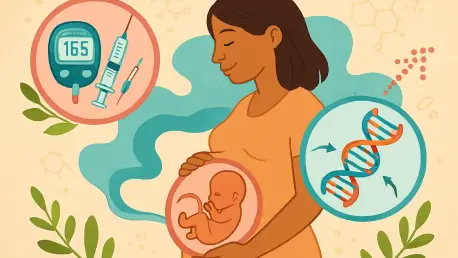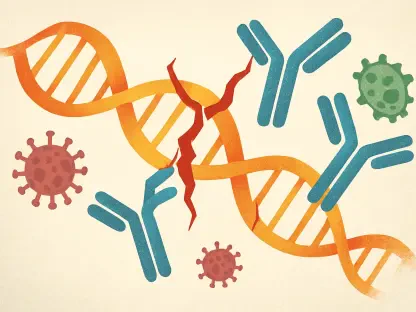I’m thrilled to sit down with Ivan Kairatov, a renowned biopharma expert with a wealth of experience in research and development, particularly in the intersection of technology and innovation in the industry. Today, we’re diving into a fascinating area of study: the protective effects of maternal type 1 diabetes on children through epigenetic programming. Ivan’s insights shed light on how a mother’s condition can influence a child’s risk of developing this autoimmune disease, the role of the intrauterine environment, and the groundbreaking discoveries around DNA methylation. We’ll explore the mechanisms behind these protective effects, the specific genetic changes observed, and what this could mean for future research and prevention strategies.
Can you start by explaining what type 1 diabetes is and how it impacts children who have a family history of the condition?
Type 1 diabetes is an autoimmune condition where the body’s immune system mistakenly attacks and destroys the insulin-producing beta cells in the pancreas. This means the body can’t produce insulin, which is crucial for regulating blood sugar levels, leaving patients dependent on external insulin for life. For children with a family history—say, a parent or sibling with type 1 diabetes—the risk of developing the disease is significantly higher, about 8 to 15 times greater than in the general population. This heightened risk comes from a mix of genetic predisposition and environmental factors that can trigger the autoimmune response early in life.
What happens in the body when someone has type 1 diabetes that makes it such a challenging condition?
When someone has type 1 diabetes, the immune system targets the beta cells in the islets of Langerhans in the pancreas. These cells are responsible for producing insulin, a hormone that helps cells absorb glucose from the bloodstream for energy. Without insulin, glucose builds up in the blood, leading to high blood sugar levels that can cause serious complications over time, like damage to blood vessels, nerves, and organs. It’s a relentless process because once those beta cells are destroyed, they don’t regenerate, which is why lifelong insulin therapy is necessary to manage the condition.
Your research highlights that children born to mothers with type 1 diabetes have a lower risk of developing the disease compared to those with fathers or siblings who have it. Can you tell us more about this intriguing finding?
Yes, it’s a really interesting observation. While children with any family history of type 1 diabetes are at a higher risk overall, those born to mothers with the condition seem to have a relatively lower chance of developing it compared to children whose fathers or siblings have it. This suggests that something unique is happening during pregnancy or early life that offers a protective effect. It’s not just about genetics—since the genetic risk is similar whether it’s the mother or father with diabetes—but rather something tied to the maternal environment or early-life exposures that might be shaping the child’s immune system in a protective way.
Why do you think this protective effect is more pronounced when the mother has type 1 diabetes rather than the father?
We believe it’s largely due to the intrauterine environment—the conditions a child is exposed to during pregnancy. When a mother has type 1 diabetes, her metabolic state, blood sugar levels, and even immune factors are different, and these can influence the developing fetus. This environment might trigger specific adaptations or programming in the child’s cells that reduce the likelihood of an autoimmune response later in life. It’s not something we see with paternal diabetes because the father doesn’t directly shape the prenatal environment in the same way.
How does the intrauterine environment specifically play a role in potentially protecting these children from type 1 diabetes?
The intrauterine environment refers to the conditions inside the womb during pregnancy, including the mother’s blood chemistry, hormones, and immune signals that the fetus is exposed to. For a mother with type 1 diabetes, managing blood sugar often involves tight control, which might create a unique metabolic setting. This could affect how the child’s immune system develops, potentially making it less likely to attack its own beta cells later. It’s like an early imprinting process where the fetus adapts to these conditions in a way that offers some protection against islet autoimmunity.
Your work focuses heavily on epigenetic changes, like DNA methylation. Can you break down what that means for someone who might not be familiar with the concept?
Absolutely. Epigenetics is the study of how environmental factors can influence gene expression without changing the DNA sequence itself. DNA methylation is one of the key mechanisms in epigenetics—it’s a process where chemical tags, called methyl groups, are added to the DNA molecule. These tags can act like switches, turning genes on or off. In the context of type 1 diabetes, certain methylation patterns in a child’s DNA, influenced by the mother’s condition during pregnancy, might suppress genes that promote autoimmunity or enhance protective ones, altering the risk of developing the disease.
Can you share some specifics about the DNA methylation changes your team discovered in children born to mothers with type 1 diabetes?
We found distinct methylation changes at several genetic locations linked to type 1 diabetes susceptibility, particularly in regions like the HOXA gene cluster and the MHC region, which is a major player in immune system regulation and diabetes risk. These changes seem to influence how genes related to immune function are expressed. Essentially, in children of mothers with type 1 diabetes, these epigenetic marks appear to dial down the activity of genes that might trigger islet autoimmunity, offering a layer of protection that we don’t see as strongly in other groups.
How did your team go about uncovering these epigenetic differences in your study?
We conducted an epigenome-wide association study involving over 1,700 children around two years old, all of whom had a genetic risk for type 1 diabetes. We analyzed blood samples to compare DNA methylation patterns between children born to mothers with type 1 diabetes and those who weren’t. By looking at nearly 800 kids with maternal exposure and over 900 without, we pinpointed specific methylation differences tied to maternal diabetes. These patterns were then linked to gene expression and the likelihood of developing islet autoimmunity, giving us a clearer picture of how these epigenetic changes might confer protection.
What do these methylation changes tell us about the child’s immune system and their risk of developing autoimmunity?
These methylation changes are significant because they often occur at genes that regulate immune responses. For instance, modifications in the MHC region can affect how the immune system recognizes and responds to threats, including whether it mistakenly targets the body’s own cells, like the beta cells in the pancreas. In children of mothers with type 1 diabetes, the specific patterns we observed seem to reduce the expression of genes that drive autoimmunity, essentially lowering the chances that the immune system will attack insulin-producing cells. It’s a subtle but powerful protective mechanism.
Looking ahead, what is your forecast for the future of research into maternal type 1 diabetes and its protective effects on children?
I’m very optimistic about where this research is headed. We’re just scratching the surface of understanding how maternal health shapes a child’s risk for diseases like type 1 diabetes through epigenetics. In the coming years, I expect we’ll see more detailed studies mapping out exactly which environmental factors during pregnancy—be it blood sugar control, immune signals, or other metabolic markers—drive these protective epigenetic changes. There’s also huge potential in translating these findings into prevention strategies, perhaps by mimicking these protective mechanisms in at-risk children who don’t have a mother with diabetes. Ultimately, I believe this could lead to innovative approaches to reduce the incidence of type 1 diabetes, combining epigenetics with personalized medicine.









